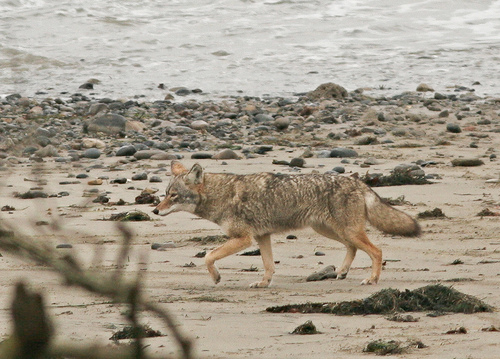Please note: Osher Rainforest will be closed for maintenance Jan. 14–16.
Science News
Coyotes’ Tastes Turn To Seafood
January 27, 2014

By Jami Smith
Coyotes aren't picky eaters—they are opportunistic and very open-minded. A coyote’s diet consists of a wide variety of flora and fauna, including small birds, rabbits, squirrels, deer, insects, berries and fruit. In urban areas, garbage and pet cats can also become a hungry coyote's meal. And a study from the University of California at Santa Cruz (UCSC) demonstrates that some coyotes are now getting a taste for seafood, too.
Rachel Brown Reid, a UCSC graduate student, and her colleagues are studying the inclusion of marine foods in present-day coyote diets. Reid recently presented their findings at the Society of Vertebrate Paleontology meeting in Los Angeles.
By comparing the bones of coastal coyotes from the Holocene period to scat samples from present-day coastal coyotes, the researchers found evidence of an increase in the amount of marine life present in coyote diets. The scientists did stable isotope and content analysis on seventeen samples of coyote scat collected in 2011 at Año Nuevo State Park and Reserve. Five of the seventeen present-day samples had relatively high carbon and nitrogen isotope values, which indicates seafood consumption. Furthermore, there was other evidence of a marine diet in the scat, like seal and sea lion hair. But the Holocene bones, which are about 2,000 years old and from archaeological sites near Moss Landing, were lower in carbon and nitrogen isotopes, not near the range expected for animals with a partially marine diet.
Reid says this suggests that the coastal coyotes’ turn toward marine foods is a more recent development. “The modern coyotes are mostly scavenging on seal carcasses and possibly on the afterbirth following seal pupping at Año Nuevo.”
Why might this have happened? Most coyotes aren’t struggling to make ends meet in our current ecosystem. In fact, studies have shown that coyotes’ numbers are up around the country. So why are they turning to this new food source?
One reason for the diet change, the scientists suggest, may involve the California grizzly bear. Grizzly bears, once ubiquitous in the state, were hunted to extinction in California in the early 1900s. Reid says that data from the bone of one grizzly bear, also a California coastal animal, has nitrogen and carbon isotope values suggestive of a purely marine diet. So the presence of grizzlies on the coast may have historically excluded coyotes from foraging there. Reid theorizes that the grizzlies’ disappearance from the ecosystem may have allowed coyotes to move in and start searching beaches for food.
Reid and her colleagues are still investigating this diet change. They hope to identify the effects it might have on the coyote’s fellow predators, their prey and the wider ecosystem. It could have far-reaching impacts on animals up and down the food chain, coastal and inland.
“We are continuing to dissect and analyze scats collected at Año Nuevo, as well as a couple of other coastal sites around Monterey Bay, to better characterize the importance of marine foods to modern coyotes,” Reid says in a email. “And we’re analyzing bones from sites that fill in the gap between 2,000 years ago and today to try and figure out when marine foods first show up in coyote diets.”
Jami Smith is a science geek-wannabe and volunteers for Science Today.
Image: Emily Hoyer via Flickr